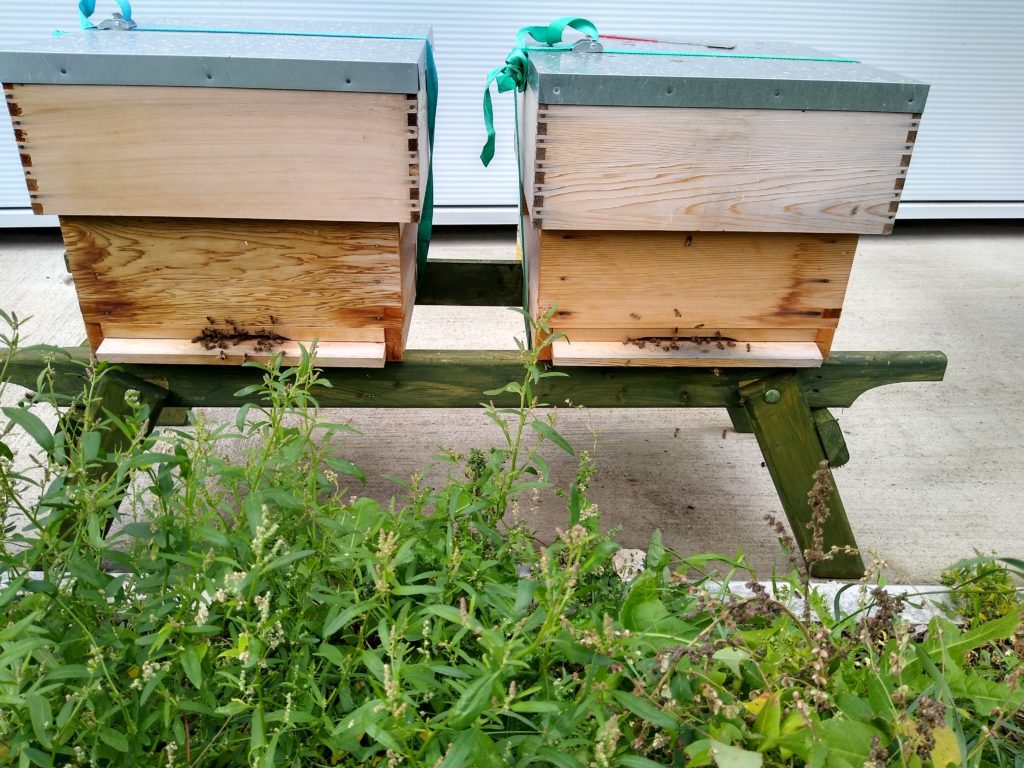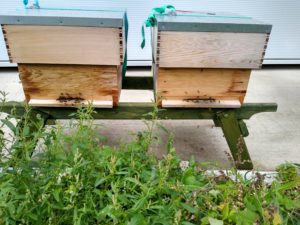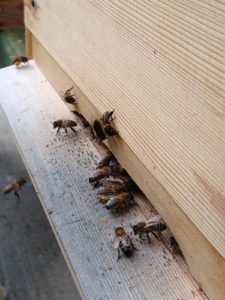
At ATC, we are always looking for ways to push our sustainability efforts further. With that intention, we recently installed Beehives at our European Headquarters in Dublin to support pollination in our local area.
Alongside the beehives themselves, we have planted fruit trees and bee-friendly shrubs and bushes that will provide food and nectar during the Spring and Summer months for the hives in the sheltered part of the property.
Today we wanted to highlight why we decided to implement beehives on our property and why we encourage other businesses and homeowners to do the same on their property – if possible.
The Importance of Bees for Our Crops
Are you aware that Wild Bees and Honeybees are responsible for pollinating fruit, vegetables, and wild plants?
Almost 90% of wild plants and 75% of global crops depend on pollination. One in every three mouthfuls of our food depends on pollinators such as bees. The pollination of crops such as apples, strawberries, and vegetables shows that pollinators are a vital contributor to our economy, with an estimated annual value of at least €35 million in the Republic of Ireland.

Why Bees are Facing Extinction
Populations of bumblebees and solitary bees all over Ireland have shrunk dramatically in the past 30 years, with ONE-Third of all species being threatened with extinction.
In Ireland, we have one type of managed Native Irish Honeybee and 98 different Wild Bees, which include 21 Bumblebees and 77 Solitary bees. Solitary bees are key to pollination.
As the food supply for bees decreases (flowers) and their safe nesting places, such as long grasses and woods, are lost, bees are becoming endangered, and about one-third are facing extinction. Potent chemical cocktails comprising insecticides, fungicides and herbicides have also contributed to their decline; Insecticides are known to kill, harm and disorientate pollinators. Herbicides that kill the ‘weeds’ are also harmful to bees.
How Can We Support the Survival of Bees
Businesses and schools can sign up with AIP – The All-Ireland Pollinator Plan, which will guide them with information around setting up and maintaining a suitable environment for their hive.
Farmers can use the sparing and land-sharing concept, where crops are interplanted with bee-friendly plants. In urban areas in some countries, the rooves of bus stops have been planted with flowers to encourage bee populations.
Plant a bee-friendly garden with trees such as Willow, Hawthorn, Rowan, Holly and Crab apple. Also, plant nectar and pollen-rich plants on your property, such as Snowdrops, Crocus, Grape, Hyacinth and Alliums, to provide early food for emerging pollinators the following Spring. Bee bombs can be ordered online from www.Beebomsbireland.com, which will help you grow bee-friendly flowers in your garden and along roadsides.
Create areas in your garden for solitary bees to make their homes, such as soil embankments, stone walls, and long grassy areas. Build a bee hotel with cones, sticks, tiles and pallets in a quiet garden corner to encourage solitary bees to stay. Allow your lawn to grow with dandelions (these are a vital food source for bees in Spring), and mow only every six weeks.
Eliminate the use of herbicides, insecticides and pesticides as these poison bees and disorientate them.

Key Considerations Before Installing a Hive
Bees can be kept in a variety of places, including rooftops, back gardens, orchards, farm fields, business sites etc. Regardless of location, it is imperative that your bees must not interfere with the rights of other people in their homes or work environments. The beehive site should be:
- Easily accessible for the beekeeper.
- Secured from predators, including animals and ‘humans’.
- Sheltered from the wind and should not be sited facing the prevailing wind.
- Ideally, an apiary site should be shaded by deciduous trees. While colonies can benefit from the Autumn, Winter, and Spring sun, in the Summer, these same hives can overheat. Thus, the beekeeper must ensure their hives are kept as cool as possible.
- Hives should have an adequate food and water source. Remember, bees will forage within a 6 km radius of the hive, so this needs to be considered.
- Ideally, hives should be sited with the entrance facing south or southeast.
Note: beekeepers need to be suited up in appropriate clothing before going near their hives.
The Process of Installing a Hive
Once a new site for a hive has been selected and the new hive installed, the existing beehive can be covered over with a muslin cloth the evening before the move. As early as possible the next morning, the hive is moved to the new site.
During transportation, the hive must be secured to prevent damage, and the roof is left off to keep the bees cool. At the new site, the hive is opened, the muslin cover is removed, and the crown board is replaced. The colony is left to settle for a few weeks before being inspected. Hives should only be moved in early Spring.
The Maintenance of a Hive
Beehives are the colony’s home and need regular maintenance, from sterilising parts once a year after a comb change to repairing gaps in the wood to prevent draughts, pests, or robbers. A hive should be kept so that bees are happy there, as they will move if they are not. Sterilising prevents pests and disease in larvae.
The beekeeping year runs from January through December.
Understandably some months are busier than others, with April through September being the busiest months. During the busy season, beekeepers are primarily concerned with preventing colonies swarming. This involves checking each colony weekly/fortnightly until you have successfully controlled swarming. Records are kept for each colony, being completed after each visit.
At ATC, we are committed to sustainable environmental practices, and we believe that every small contribution counts towards improving our environment, our communities, and the world around us.
We have found this whole process fascinating, and we would like to take this opportunity to sincerely thank our beekeeper Nessa Friel for her expertise, guidance and insights around this project.
Deborah Murray
Executive Assistant
Further information can be found at:
- The Bee Book by Fergus Chadwick et al
- Learn these top 10 facts about bees | WWF
- www.Beebomsbireland.com
- pollinators.ie


